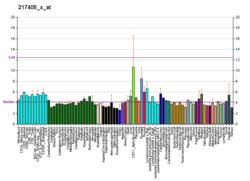GPLD1
Phosphatidylinositol-glycan-specific phospholipase D is an enzyme that in humans is encoded by the GPLD1 gene.[5][6]
Many proteins are tethered to the extracellular face of eukaryotic plasma membranes by a glycosylphosphatidylinositol (GPI) anchor. The GPI-anchor is a glycolipid found on many blood cells. The protein encoded by the GPLD1 gene is a GPI degrading enzyme that hydrolyzes the inositol phosphate linkage in proteins anchored by phosphatidylinositol glycans, thereby releasing the attached protein from the plasma membrane.[6]
Plasma concentrations of Gpld1 in mice were found to increase after exercise and to correlate with improved cognitive function, and concentrations of GPLD1 in blood were increased in active elderly humans.[7][8]
Interactions
GPLD1 has been shown to interact with Apolipoprotein A1[9] and APOA4.[9]
References
- GRCh38: Ensembl release 89: ENSG00000112293 - Ensembl, May 2017
- GRCm38: Ensembl release 89: ENSMUSG00000021340 - Ensembl, May 2017
- "Human PubMed Reference:". National Center for Biotechnology Information, U.S. National Library of Medicine.
- "Mouse PubMed Reference:". National Center for Biotechnology Information, U.S. National Library of Medicine.
- Schofield JN, Rademacher TW (November 2000). "Structure and expression of the human glycosylphosphatidylinositol phospholipase D1 (GPLD1) gene". Biochimica et Biophysica Acta. 1494 (1–2): 189–94. doi:10.1016/s0167-4781(00)00194-9. PMID 11072085.
- "Entrez Gene: GPLD1 glycosylphosphatidylinositol specific phospholipase D1".
- Horowitz AM, Fan X, Bieri G, Smith LK, Sanchez-Diaz CI, Schroer AB, et al. (July 2020). "Blood factors transfer beneficial effects of exercise on neurogenesis and cognition to the aged brain". Science. 369 (6500): 167–173. doi:10.1126/science.aaw2622. PMID 32646997.
- Harris R (9 June 2020). "An Enzyme That Increases With Exercise Can Improve Memory In Mice, And Maybe People". National Public Radio.
- Deeg MA, Bierman EL, Cheung MC (March 2001). "GPI-specific phospholipase D associates with an apoA-I- and apoA-IV-containing complex". Journal of Lipid Research. 42 (3): 442–51. PMID 11254757.
Further reading
- Hoener MC, Brodbeck U (June 1992). "Phosphatidylinositol-glycan-specific phospholipase D is an amphiphilic glycoprotein that in serum is associated with high-density lipoproteins". European Journal of Biochemistry. 206 (3): 747–57. doi:10.1111/j.1432-1033.1992.tb16981.x. PMID 1606959.
- Scallon BJ, Fung WJ, Tsang TC, Li S, Kado-Fong H, Huang KS, Kochan JP (April 1991). "Primary structure and functional activity of a phosphatidylinositol-glycan-specific phospholipase D". Science. 252 (5004): 446–8. Bibcode:1991Sci...252..446S. doi:10.1126/science.2017684. PMID 2017684.
- Metz CN, Brunner G, Choi-Muira NH, Nguyen H, Gabrilove J, Caras IW, et al. (April 1994). "Release of GPI-anchored membrane proteins by a cell-associated GPI-specific phospholipase D". The EMBO Journal. 13 (7): 1741–51. doi:10.1002/j.1460-2075.1994.tb06438.x. PMC 395007. PMID 7512501.
- Jinnai H, Nakamura S (August 1999). "Characterization of phospholipase D activation by GM2 activator in a cell-free system". The Kobe Journal of Medical Sciences. 45 (3–4): 181–90. PMID 10752311.
- Deeg MA, Bierman EL, Cheung MC (March 2001). "GPI-specific phospholipase D associates with an apoA-I- and apoA-IV-containing complex". Journal of Lipid Research. 42 (3): 442–51. PMID 11254757.
- Tang J, Li W (2002). "[Methodological study on the assay of glycosylphosphatidylinositol-specific phospholipase D activity in serum]". Hunan Yi Ke Da Xue Xue Bao = Hunan Yike Daxue Xuebao = Bulletin of Hunan Medical University. 24 (2): 119–22. PMID 11938765.
- Slomiany A, Nishikawa H, Slomiany BL (March 2002). "Screening and modulation of extracellular signals by mucous barrier. Serum glycosylphosphatidylinositol phospholipase D (GPI-PLD) releases protective mucous barrier from oral mucosa". Journal of Physiology and Pharmacology. 53 (1): 21–38. PMID 11939716.
- Jaworek J, Bonio J, Leja-Szpa A, Nawrot K, Tomaszewska MR, Stachura J, et al. (March 2002). "Sensory nerves in central and peripheral control of pancreatic integrity by leptin and melatonin". Journal of Physiology and Pharmacology. 53 (1): 51–74. PMID 11939719.
- Deeg MA, Bowen RF (2002). "Phosphorylation decreases trypsin activation and apolipoprotein al binding to glycosylphosphatidylinositol-specific phospholipase D". Biochemistry and Cell Biology = Biochimie Et Biologie Cellulaire. 80 (2): 253–60. doi:10.1139/o02-004. PMID 11989719.
- Xiaotong H, Hannocks MJ, Hampson I, Brunner G (2002). "GPI-specific phospholipase D mRNA expression in tumor cells of different malignancy". Clinical & Experimental Metastasis. 19 (4): 291–9. doi:10.1023/A:1015545407700. PMID 12090469.
- Magnusson P, Sharp CA, Farley JR (November 2002). "Different distributions of human bone alkaline phosphatase isoforms in serum and bone tissue extracts". Clinica Chimica Acta; International Journal of Clinical Chemistry. 325 (1–2): 59–70. doi:10.1016/S0009-8981(02)00248-6. PMID 12367767.
- Tang JH, Gu SL, Zhang XJ (April 2001). "[Preliminary study of the gene structure of human glycosylphosphatidylinositol specific phospholipase D]". Hunan Yi Ke Da Xue Xue Bao = Hunan Yike Daxue Xuebao = Bulletin of Hunan Medical University. 26 (2): 95–7. PMID 12536633.
- Kurtz TA, Fineberg NS, Considine RV, Deeg MA (February 2004). "Insulin resistance is associated with increased serum levels of glycosylphosphatidylinositol-specific phospholipase D". Metabolism. 53 (2): 138–9. doi:10.1016/j.metabol.2003.09.004. PMID 14767861.
- Lugli EB, Pouliot M, Portela M, Loomis MR, Raper J (November 2004). "Characterization of primate trypanosome lytic factors". Molecular and Biochemical Parasitology. 138 (1): 9–20. doi:10.1016/j.molbiopara.2004.07.004. PMID 15500911.
- Everett PB, Senogles SE (November 2004). "D3 dopamine receptor activates phospholipase D through a pertussis toxin-insensitive pathway". Neuroscience Letters. 371 (1): 34–9. doi:10.1016/j.neulet.2004.08.033. PMID 15500962.
- Mead KI, Zheng Y, Manzotti CN, Perry LC, Liu MK, Burke F, et al. (April 2005). "Exocytosis of CTLA-4 is dependent on phospholipase D and ADP ribosylation factor-1 and stimulated during activation of regulatory T cells". Journal of Immunology. 174 (8): 4803–11. doi:10.4049/jimmunol.174.8.4803. PMID 15814706.






